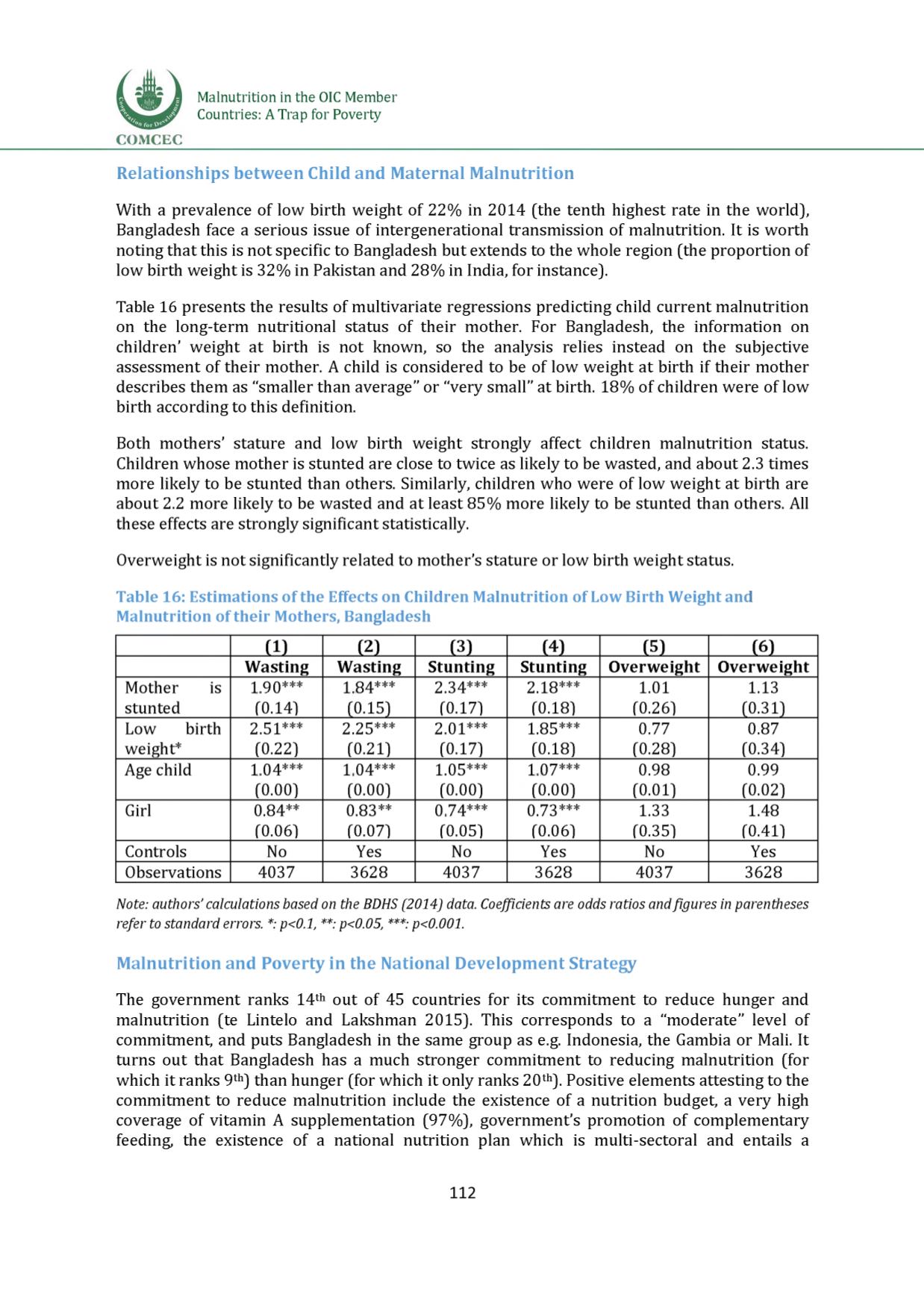

Malnutrition in the OIC Member
Countries: A Trap for Poverty
COMCEC
Relationships between Child and Maternal Malnutrition
With a prevalence of low birth weight of 22% in 2014 (the tenth highest rate in the world),
Bangladesh face a serious issue of intergenerational transmission of malnutrition. It is worth
noting that this is not specific to Bangladesh but extends to the whole region (the proportion of
low birth weight is 32% in Pakistan and 28% in India, for instance).
Table 16 presents the results of multivariate regressions predicting child current malnutrition
on the long-term nutritional status of their mother. For Bangladesh, the information on
children' weight at birth is not known, so the analysis relies instead on the subjective
assessment of their mother. A child is considered to be of low weight at birth if their mother
describes them as “smaller than average” or “very small” at birth. 18% of children were of low
birth according to this definition.
Both mothers' stature and low birth weight strongly affect children malnutrition status.
Children whose mother is stunted are close to twice as likely to be wasted, and about 2.3 times
more likely to be stunted than others. Similarly, children who were of low weight at birth are
about 2.2 more likely to be wasted and at least 85% more likely to be stunted than others. All
these effects are strongly significant statistically.
Overweight is not significantly related to mother's stature or low birth weight status.
Table 16: Estimations of the Effects on Children Malnutrition of LowBirth Weight and
Malnutrition of their Mothers, Bangladesh
(
1
)
(
2
)
(3)
(4)
(5)
(
6
)
Wasting Wasting Stunting Stunting Overweight Overweight
Mother
is
1
90***
1
84***
2.34***
2.18***
1 . 01
1.13
stunted
(0.14)
(0.15)
(0.17)
(0.18)
(0.26)
(0.31)
Low
birth 2.51***
2.25***
2
.
0 1
***
1.85***
0.77
0.87
weight*
(
0
.
2 2
)
(
0
.
2 1
)
(0.17)
(0.18)
(0.28)
(0.34)
Age child
1
04***
1
04***
1.05***
1
07***
0.98
0.99
(
0
.
0 0
)
(
0
.
0 0
)
(
0
.
0 0
)
(
0
.
0 0
)
(
0
.
0 1
)
(
0
.
0 2
)
Girl
0.84**
0.83**
0
7 4
***
0.73***
1.33
1.48
(0.06)
(0.07)
(0.05)
(0.06)
(0.35)
(0.41)
Controls
No
Yes
No
Yes
No
Yes
Observations
4037
3628
4037
3628
4037
3628
Note: authors' calculations based on the BDHS (2014) data. Coefficients are odds ratios andfigures in parentheses
refer to standard errors. *: p<0.1, **: p<0.05, ***: p<0.001.
Malnutrition and Poverty in the National Development Strategy
The government ranks 14th out of 45 countries for its commitment to reduce hunger and
malnutrition (te Lintelo and Lakshman 2015]. This corresponds to a “moderate” level of
commitment, and puts Bangladesh in the same group as e.g. Indonesia, the Gambia or Mali. It
turns out that Bangladesh has a much stronger commitment to reducing malnutrition (for
which it ranks 9th) than hunger (for which it only ranks 20th). Positive elements attesting to the
commitment to reduce malnutrition include the existence of a nutrition budget, a very high
coverage of vitamin A supplementation (97%), government's promotion of complementary
feeding, the existence of a national nutrition plan which is multi-sectoral and entails a
112
















